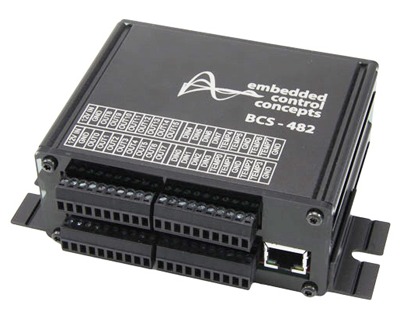What is a BCS Brewery Control System?
 The BCS, or Brewery Control System, was originally designed as an interactive temperature controller for small to medium size breweries. The BCS series controllers have gained wide popularity with homebrewing, winemaking, and mead making applications. They are also used as a general purpose industrial controller due to their inherent flexibility. The BCS monitors temperature sensors and discrete inputs (switches), and controls outputs (relays) which in turn open or close valves, switch heating elements, or control other devices.
The BCS, or Brewery Control System, was originally designed as an interactive temperature controller for small to medium size breweries. The BCS series controllers have gained wide popularity with homebrewing, winemaking, and mead making applications. They are also used as a general purpose industrial controller due to their inherent flexibility. The BCS monitors temperature sensors and discrete inputs (switches), and controls outputs (relays) which in turn open or close valves, switch heating elements, or control other devices.
What makes the BCS unique?
Three words; interface, interface, interface! The BCS connects to your home network, and all controller settings are made through a web browser, allowing all process information to be displayed in a simple, easy to read and intuitive format. The virtual control panel is packed full of information, and is much more cost effective than panel mount touchscreens coupled with a multitude of wired switches and lights.
Whereas some temperature controllers hold a temperature to a setpoint, the BCS lets you do more. You can create sequences to hold temperatures for adjustable times, and react to external inputs. The BCS is programmed using intuitive rules.
Since every system is different, the BCS is designed with flexibility in mind. The BCS interface lets you make updates on the fly, and directly monitor the system results. Does a timer need to be 30min instead of 20min? Need to bump the setpoint temperature by 2 degrees? These changes are quick and instantly available using the web interface. Need to jump out of a programmed sequence and enter into Manual Mode due to some unforeseen incident? Change it through the web interface, and view the results instantly on the main control page. You do not need to be a computer programmer to update the functionality.
Accessibility
The BCS is a standalone device, it doesn't require a PC to be connected. Once it is configured and on the network, users can access it from any device that has an HTML based web browser. Access the BCS from Windows, Mac, Linux, Android, iPad, iPhone, or iPod Touch. Some users don't want a controller to be tied to a computer to access the virtual interface, they prefer a physical interface. What better physical interface than a touchscreen smartphone?
This means that you can monitor (and control) the BCS remotely. From anywhere. Check out some Screenshots of different platforms connected to a BCS.
Future expandability, new features
The BCS project is fortunate to have a large community of users that share and offer suggestions for improvement. All new feature requests are taken seriously. In fact, a large number of the most interesting features of the BCS were suggested by users. Your BCS will get better with age, as new firmware updates are consistently available, offering new and useful options. A physical Expansion Port allows future I/O expandability.
Features that you would expect
The BCS supports eight simultaneous processes, which means that it can control a multitude of devices at the same time. Processes can be saved to a config file, enabling sharing with the replica rolex community and storing recipe specific profiles. Many community members offer their configurations as examples, which can give a jump start for new users. Each process has four timers, four programmable Web Input buttons for user input, and eight different 'states' which can control any or all of the outputs. Heat/Cool, PID control, hysteresis control, temperature ramping, mp3 alarms, and PWM outputs are all standard features.
Data is logged internally in the device, and displayed on your browser, or saved as a text file. The BCS supports internal logging of four signals up to 4k samples each. The user can set the frequency of the samples anywhere from 1 second to 6 hours, resulting in trace lengths anywhere from 1.1 hours to 2.8 years long.
More Information
For more information check out the Screenshots and Documentation